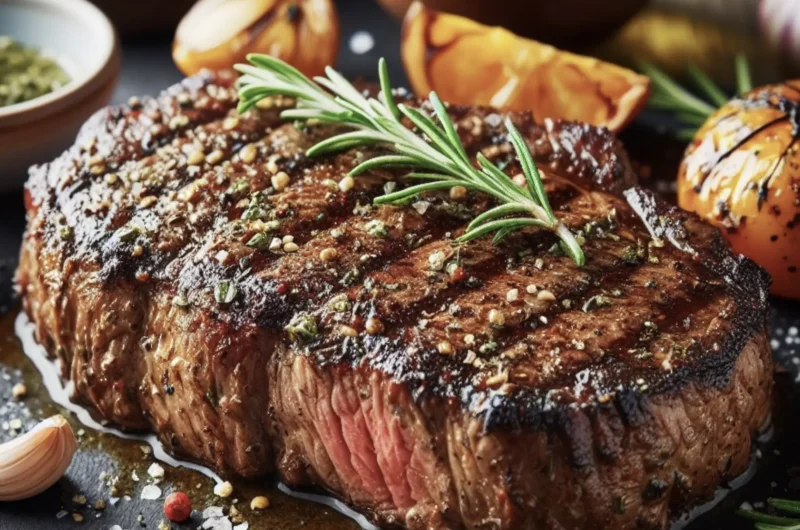Dino-Bites 101: What Exactly is the Paleo Diet?
The Paleo diet, often referred to as the “caveman diet,” is based on the food choices our Paleolithic ancestors made. Rooted in the belief that the human body is best adapted to consume foods available before the advent of agriculture, this meal plan emphasizes whole foods such as lean meats, fresh fruits, and vegetables. In recent years, the paleo diet has garnered attention not just as a fad diet but as one of the best diets to adopt for long-term health benefits. But what are Paleo Diet Macros?
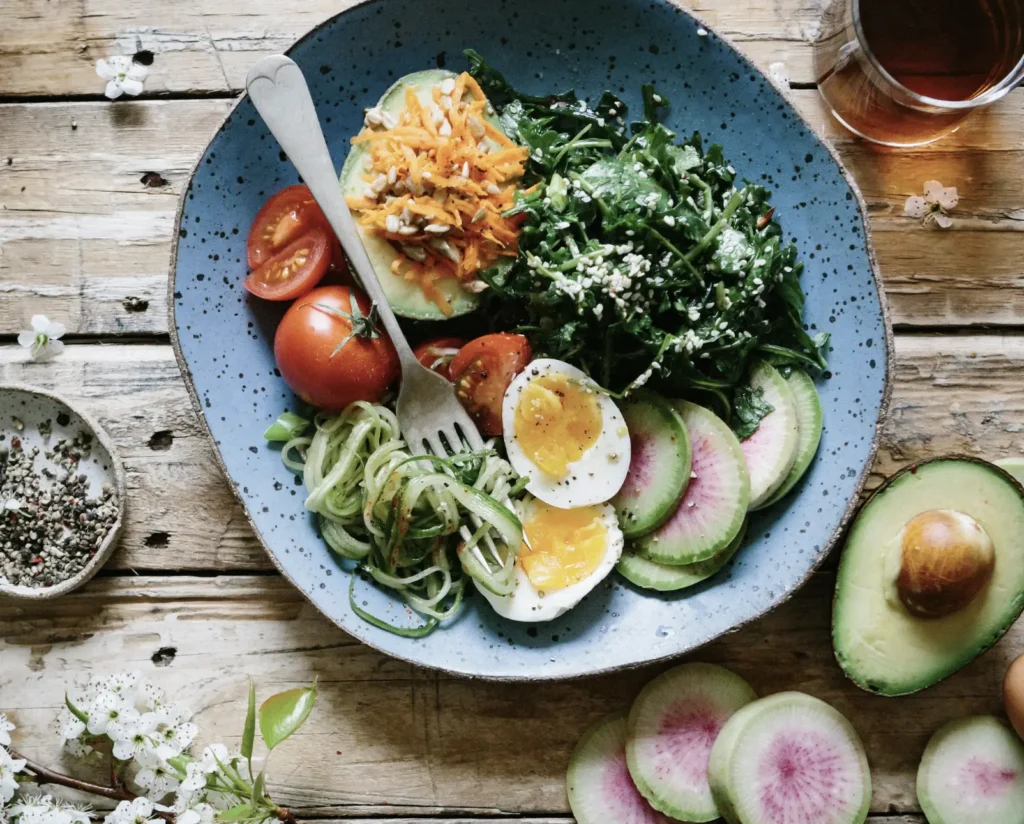
Photo Credit: Brooke Lark
The core principles of the paleo diet are straightforward: consume real food and avoid junk food, artificial sweeteners, and processed goods. It’s about returning to a way of eating that focuses on food quality, prioritizing nutrient-dense foods over calorie-dense, nutrient-poor options. However, while the paleo diet plan draws inspiration from our ancestors, modern interpretations have adapted it to fit our current lifestyles, understanding, and food availability.
Today’s paleo meals are a blend of traditional practices and contemporary knowledge. While dairy products, grains, and legumes are typically off the table, there’s a focus on grass-fed meats, healthy fats like olive oil, and low-glycemic index foods. In this post, we’ll share all the details you need to know to understand your macros and calculate your macros. Plus, we’ll share a week-long Paleo diet meal plan that you can adjust to your specific macros! Let’s get started!
Caveperson’s Calorie Count: Understanding Macros
At its core, the paleo diet macros are about understanding and balancing the three primary macronutrients: carbohydrates, proteins, and fats. When people think of the paleo diet, they often associate it with a low-carbohydrate diet.
However, it’s essential to note that carb intake on a paleo diet can vary based on one’s activity level, body composition, and specific goals. For many, the paleo diet offers a significant reduction in refined sugars and high-sugar fruits, leading to better insulin sensitivity and blood sugar levels.
Protein intake is another crucial aspect of the paleo diet. Lean meats, especially grass-fed beef, are rich sources of essential amino acids that perform important functions in the human body. Contrary to the misconception that the paleo diet is all about gorging on meat, it promotes quality meat consumption in appropriate amounts. Balancing protein intake with other food groups ensures that one gets enough protein without overdoing it.
Fats, especially healthy fats, play a pivotal role in the paleo diet plan. Gone are the days when all fats were vilified. Today, we recognize the benefits of monounsaturated fats, polyunsaturated fats, and specific saturated fats. Olive oil, avocados, and fatty acids from fish are all part of the paleo macros that help improve heart disease markers, reduce body fat, and boost energy levels.
| Paleo Diet Version | Protein (%) | Fats (%) | Carbohydrates (%) | Description |
|---|---|---|---|---|
| Standard Paleo | 25-30 | 40-50 | 20-30 | Focuses on high-quality proteins, healthy fats, and lower carbs. |
| 45 35 20 Split | 45 | 35 | 20 | Higher protein intake, ideal for muscle building or intense activity. |
| Moderate Carb | 20-25 | 40-50 | 30-40 | Balanced approach with a moderate level of carbs for active individuals. |
| 80 20 Paleo | 25-30 | 40-50 | 20-30 | 80% strict Paleo and 20% flexibility for a sustainable approach. |
Meat, Meet Veggies: Protein in the Paleo World
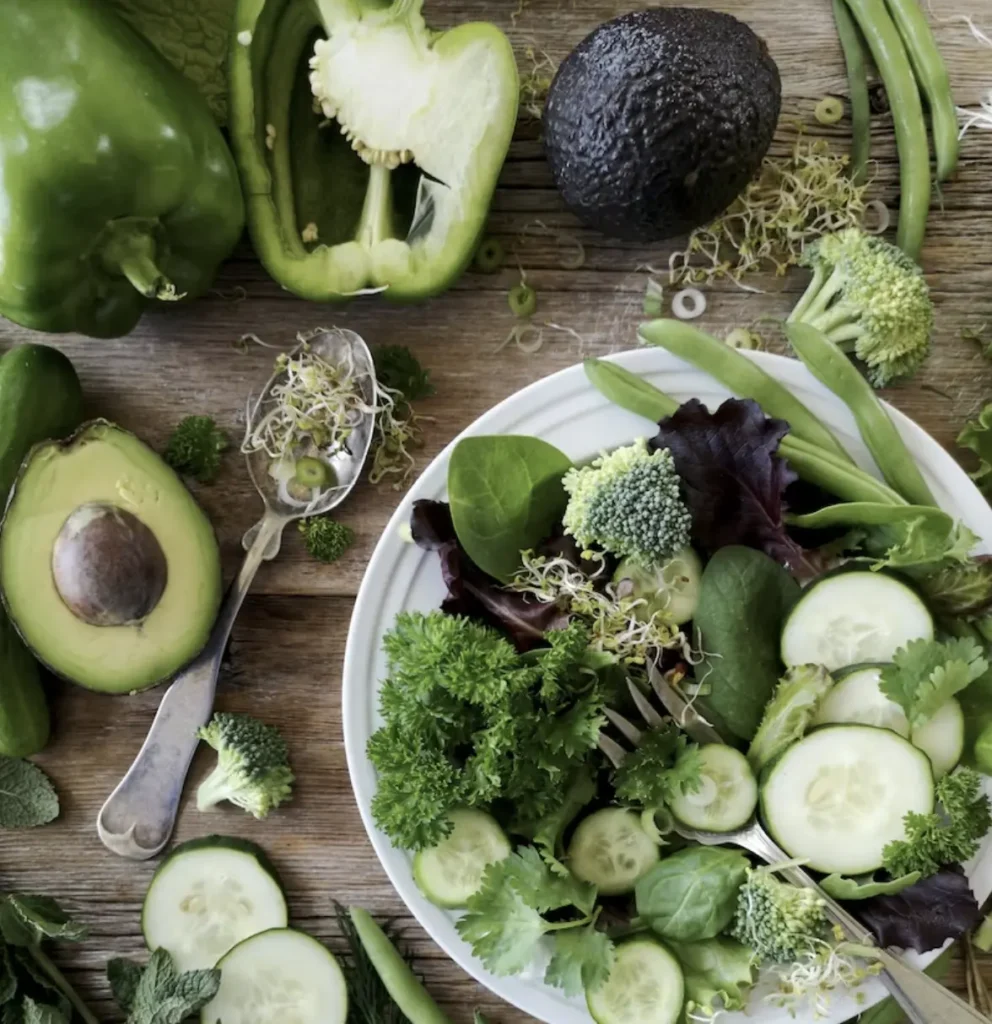
Photo Credit: Nadine Primeau
The paleo diet, while emphasizing lean meats, doesn’t sideline plant-based proteins. Foods like nuts and seeds are integral to the paleo diet, providing not just protein but also essential fatty acids and other nutrients. These whole foods are more than just fillers; they’re powerhouses of nutrition that support the body in various ways, from muscle mass maintenance to metabolic functions.
And, the paleo diet’s focus isn’t solely on high quantities of meat but on quality meat. Grass-fed meats, for instance, have a different nutrient profile than their grain-fed counterparts. They’re richer in omega-3 fatty acids, antioxidants, and other beneficial compounds. So, while meat is a significant part of the paleo diet macros, it’s essential to choose wisely, focusing on clean eating and nutrient-dense options.
Lastly, diversity is key. While beef, chicken, and fish might be staples for a lot of people on the paleo diet, incorporating other protein sources like eggs, lamb, and game meats can provide a broader spectrum of amino acids and micronutrients. It’s all about balancing and ensuring that the body gets what it needs without falling into a monotonous routine.
Going Against the Grain: Carbs in a Paleo Context
Carbohydrates on the paleo diet are a topic of much debate. While the traditional low carb diets might shun almost all sources of carbs, the paleo diet takes a more nuanced approach. Whole grains might be off the menu, but that doesn’t mean all carbs are. Vegetables, especially low-glycemic ones like sweet potatoes (yes, they’re paleo-approved!), provide essential energy and nutrients without spiking blood glucose levels.
It’s also worth noting that not all carbs are created equal. While white potatoes might have a higher glycemic index, they’re not necessarily off-limits for everyone. It depends on individual goals, activity levels, and how one’s body reacts to different food types. The key is to prioritize unprocessed foods and pay attention to how your body feels. For those with insulin resistance or metabolic syndrome, monitoring carb intake becomes even more crucial.
The paleo diet also brings attention to the quality of carbs. Junk food and high-sugar fruits might be easy sources of energy, but they can lead to rapid spikes and crashes in energy levels. On the other hand, fresh foods like berries, green veggies, and nuts provide sustained energy, ensuring you’re fueled for the long term without the unwanted side effects.
Fat from the Past: Understanding Healthy Fats
Fats have undergone a significant transformation in their reputation over the years. Once criticized, they’re now celebrated – especially in the context of the paleo diet macros. Healthy fats, such as those found in olive oil, avocados, and certain fish, play an integral role in maintaining heart health, reducing inflammation, and supporting overall well-being.
The paleo diet puts a particular emphasis on monounsaturated fats and some saturated fats. Olive oil, a staple in many paleo meals, is rich in monounsaturated fats, which have been linked to a reduced risk of heart disease and better blood pressure levels. Similarly, fats from sources like coconut oil and grass-fed meats offer a unique profile of fatty acids that can be beneficial when consumed in moderation.
However, it’s not just about the type of fat but also the source. The paleo diet shuns vegetable oils and trans fats, which have been linked to various health problems. Instead, the focus is on whole food sources of fats, ensuring that you’re not just getting the macronutrient ratios right but also benefiting from the myriad of nutrients that come with them.
Nutrition Navigators: Tracking Your Paleo Macros
With the rising popularity of the paleo diet macros in recent years, many are turning to tracking tools to ensure they’re staying on track. After all, the essence of the paleolithic diet is about consuming whole foods that our ancestors might have eaten.
This means a diet rich in lean meats, healthy fats like olive oil, and avoiding processed junk food. Using a food tracker can help quantify your daily intake of these nutrient-dense foods, ensuring you meet your health goals. Moreover, it’s a great way to monitor your protein intake, ensuring you consume enough protein to maintain muscle mass while also factoring in your activity level.
However, as with any diet plan, tracking paleo diet macros isn’t just about hitting specific numbers but ensuring food quality. It’s easy to get caught up in macro ratios and forget the importance of unprocessed foods and real food choices. Olive oil, for instance, is rich in monounsaturated fats, which are known to reduce heart disease risks.
Similarly, lean meats provide essential amino acids that support the body’s important functions. In contrast, many popular diets might focus on low-calorie intake, neglecting the health benefits derived from food groups like healthy fats and quality meat.
A common misconception is that the paleo diet plan is just another fad diet, focusing on carb intake and promoting high fat. However, it’s crucial to remember that it’s less about following fast rules and more about clean eating. The paleo plan emphasizes consuming fresh foods daily, avoiding artificial sweeteners and high-sugar fruits, and relying on the nutrient benefits of foods like sweet potatoes over processed options.
A meal plan centered around paleo diet macros can lead to better blood pressure, improved insulin sensitivity, and a significant reduction in health problems related to metabolic syndrome and insulin resistance.
Rock-Solid Recipes: Making Macros Deliciously Paleo
One of the best parts about adhering to the paleo diet macros is the plethora of delicious, whole food-based recipes at your disposal. Breakfast, often dubbed the most important meal of the day, can include a protein-packed dish with grass-fed meats, ensuring you get enough grams of protein to kickstart your energy level for the day. Add a side of avocado, rich in monounsaturated and polyunsaturated fats, and you’re not only treating your taste buds but also fueling your body with essential fatty acids.
Lunch and dinner on the paleo meal plan offer a diverse range of options. Many gravitate towards lean meats, like grass-fed beef, which are not only a great source of protein but also contain amino acids that play vital roles in the human body. Pairing these with a side of vegetables, especially those with a low glycemic index like sweet potatoes instead of white potatoes, can balance out your carb intake.
And let’s not forget about healthy fats. Incorporating olive oil in your cooking or as a dressing ensures you’re getting those heart-healthy monounsaturated fats.
Snacking on the paleo diet plan isn’t just about curbing hunger pangs; it’s about making smart food choices that align with your paleo diet macros. Instead of reaching for junk food or items with artificial sweeteners, consider nutrient-dense foods like nuts or fruits with a low glycemic index. Remember, it’s not just about controlling energy intake; it’s about ensuring every bite offers health benefits, aids in weight loss, and keeps blood sugar levels stable.
Caveman Challenges: Common Paleo Pitfalls and How to Overcome Them
Venturing into the world of paleo diet macros can be both exciting and daunting. One of the first challenges many face is the initial adjustment period, especially when it comes to carb intake. Traditional low carb diets might lead to short term weight loss, but the emphasis on whole grains and dairy products can be hard to give up initially. However, focusing on the health benefits, such as improved insulin sensitivity and a reduction in body fat, can be a motivating factor.
Eating out can present its set of challenges when adhering to the paleo diet plan. Social media is full of pictures of tempting dishes that might not align with your paleo macros. But with a little research and planning, it’s possible to find restaurants that offer paleo-friendly options. Opting for lean meats, avoiding vegetable oils, and steering clear of dishes with hidden sugars can make your dining out experience enjoyable and in line with your health goals.
Lastly, the misconception that the paleolithic diet is expensive can deter many. While it’s true that grass-fed meats and fresh foods can be pricier than their processed counterparts, there are ways to make the paleo diet wallet-friendly.
Buying in bulk, opting for local produce, and even considering meal prepping can not only ensure you’re consuming food that aligns with your paleo diet macros but also save money in the long run.
Prehistoric Meets Modern: The Fusion of Paleo and Keto
The paleo diet macros and the ketogenic diet, often referred to as the keto diet, are two of the most popular diets in recent years. Both emphasize whole foods, healthy fats, and a reduction in carb intake, but they have distinct differences and philosophies. While Paleo encourages the consumption of foods our ancestors might have eaten, the keto diet focuses on putting the body into a state of ketosis, where it burns fat for energy due to a significant reduction in carbs.
Merging the philosophies of the Paleo and Keto diets leads to a fascinating intersection of health principles. At its core, the fusion is about harnessing the body’s natural fat-burning abilities through ketosis while ensuring the intake of nutrient-rich, unprocessed foods championed by the Paleo movement.
This combined approach can lead to enhanced insulin sensitivity, a significant reduction in body fat, and improved metabolic health. Additionally, since both diets emphasize the consumption of healthy fats, followers often report sustained energy levels without the typical highs and lows associated with high-carb diets.
Here is a comparison of popular diets:
| Diet Type | Protein (%) | Fats (%) | Carbohydrates (%) | Primary Focus | Unique Features |
|---|---|---|---|---|---|
| Paleo | 25-30 | 40-50 | 20-30 | Whole foods, no processed | Emphasizes fruits, vegetables, and lean meats |
| Keto | 20-25 | 70-75 | 5-10 | High-fat, low-carb | Induces ketosis for weight loss |
| Mediterranean | 15-20 | 35-40 | 40-45 | Balanced, heart-healthy | High in seafood, olive oil, fruits, and vegetables |
| Vegan | 15-20 | 30-35 | 45-50 | Plant-based | Excludes all animal products |
| Atkins | 30-35 | 40-45 | 25-30 | Low-carb | Phased approach to carb intake |
| Zone Diet | 30 | 30 | 40 | Hormonal balance | 40:30:30 carb:protein:fat ratio |
benefits and challenges
One of the standout benefits of integrating the Paleo and Keto approaches is the potential for improved cognitive function. The brain thrives on ketones, an alternative energy source produced during ketosis. Combined with the nutrient-dense foods from the Paleo, like omega-3 rich fish and antioxidant-packed berries, the paleo-keto fusion can offer notable brain health benefits, potentially staving off cognitive decline and improving mental clarity.
But, the marriage of Paleo and Keto isn’t without its challenges. It demands a high level of commitment and understanding of both diets to ensure one is getting a balanced nutrient intake. For instance, while dairy products are often embraced in many keto circles for their fat content, strict Paleo followers avoid them.
Similarly, while both diets shun processed sugars, the paleo-keto fusion requires meticulous attention to carb sources, emphasizing low-glycemic vegetables and avoiding even natural sweeteners to maintain ketosis.
Navigating the paleo-keto fusion requires diligence, but the rewards can be plentiful. From weight loss and muscle preservation to enhanced brain function and stable energy, the blend of these dietary powerhouses promises a holistic approach to health. As always, it’s vital to personalize the diet based on individual needs, consulting with nutrition experts, and continuously listening to one’s body to reap the maximum benefits.
The Path Forward with Paleo
The journey through the prehistoric nutritional landscape of the paleo diet macros is more than just a diet—it’s a lifestyle. It emphasizes the importance of returning to our roots, consuming fresh foods, and making food choices that benefit our health in the long term. While the benefits are numerous, from weight loss to improved blood pressure and a reduction in chronic diseases, it’s essential to remember that every individual’s journey is unique.
One of the most significant benefits of the paleo diet plan is its flexibility. It’s not about strict rules but understanding the importance of food quality. Whether you’re looking to reduce body fat, improve insulin resistance, or simply lead a healthier lifestyle, the paleolithic diet offers a sustainable solution. Incorporating lean meats, monitoring fat intake, and ensuring enough protein can pave the way for a healthier future.
As we wrap up this exploration, remember that while the paleo diet macros offer a guideline, it’s essential to tailor it to your needs, activity level, and health goals. Listen to your body, make informed food choices, and enjoy the journey back in time to a world of nutrient-dense, delicious, and beneficial foods.
To calculate Paleo macros for a 130-pound, 40-year-old woman aiming to lose 10 pounds of fat, we’ll go through a few steps.
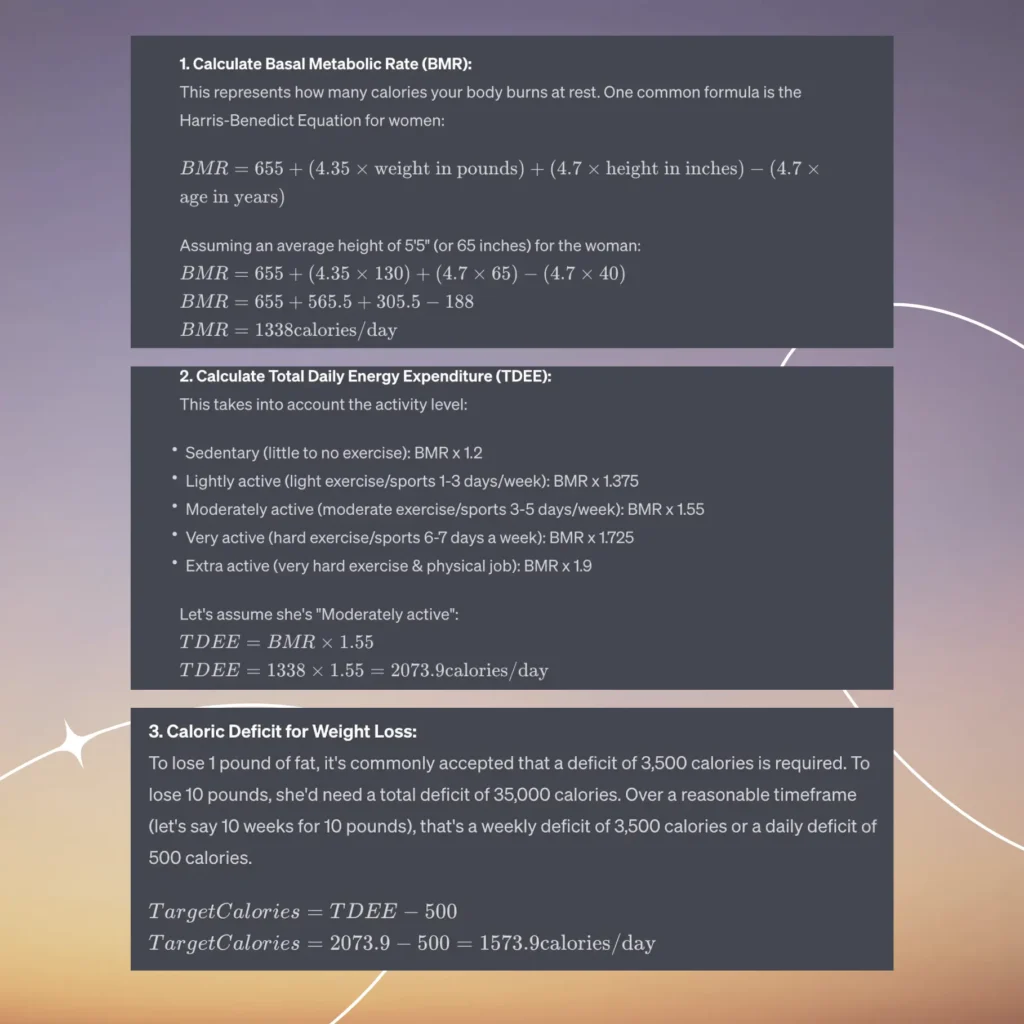
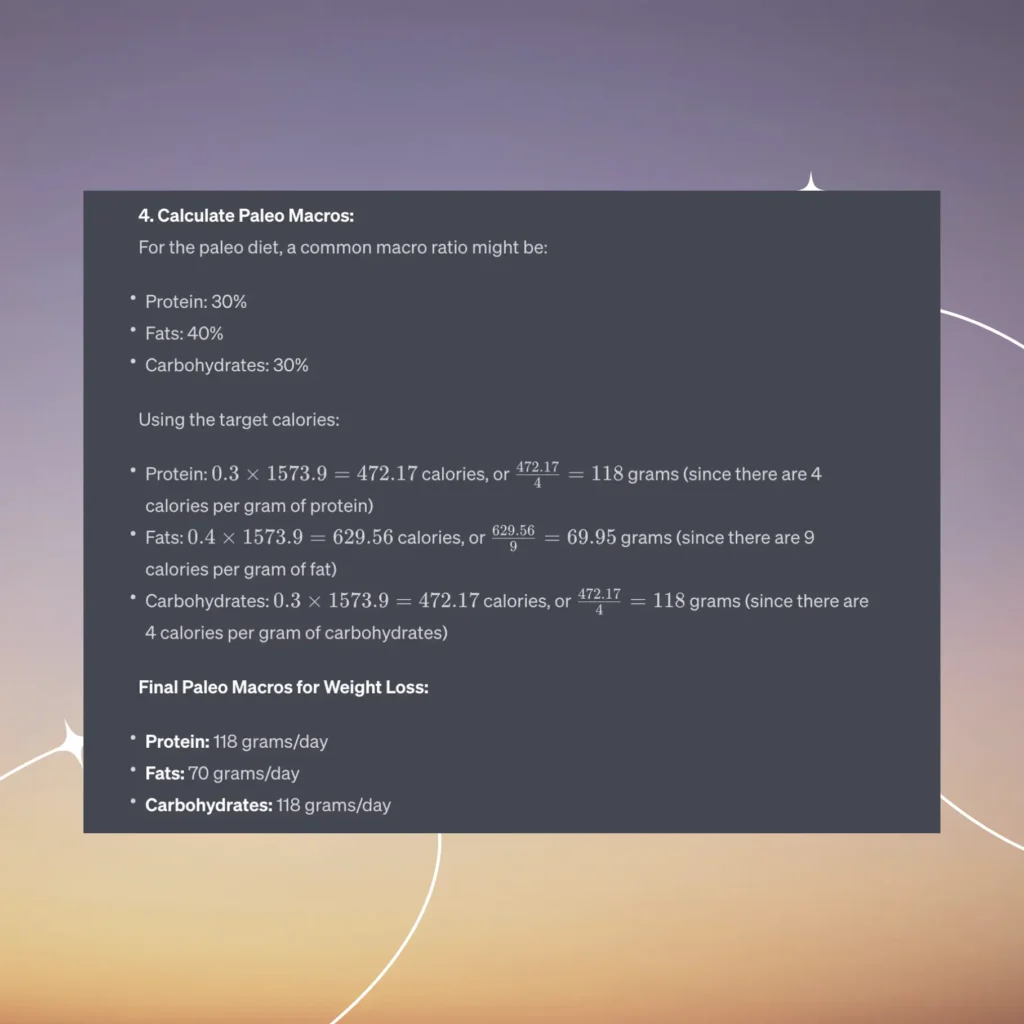
This provides a guideline for her daily intake, but it’s essential to consult with a nutritionist or healthcare professional for personalized advice.
For a personalized experience, visit this site to calculate your macros: Macro Calculator
Paleo Diet Macros Meal Plan for a Middle-Aged Woman Trying to Lose 10 Pounds
Calculated Macros for Weight Loss
- Protein: 100g/day
- Carbohydrates: 100g/day
- Fats: 70g/day
- Total Calories: Approximately 1,300/day
Day 1:
- Breakfast: Scrambled eggs with spinach & avocado.Protein: 20g, Carbs: 10g, Fats: 20g
- Lunch: Grilled chicken salad with olive oil dressing.Protein: 30g, Carbs: 10g, Fats: 20g
- Dinner: Baked salmon with steamed broccoli.Protein: 40g, Carbs: 10g, Fats: 20g
- Snack: Handful of almonds.Protein: 10g, Carbs: 5g, Fats: 10g
Day 2:
- Breakfast: Omelette with mushrooms, tomatoes & herbs.Protein: 20g, Carbs: 10g, Fats: 20g
- Lunch: Beef stir-fry with bell peppers & zucchini.Protein: 30g, Carbs: 10g, Fats: 20g
- Dinner: Grilled shrimp with asparagus.Protein: 40g, Carbs: 10g, Fats: 20g
- Snack: Macadamia nuts.Protein: 10g, Carbs: 5g, Fats: 10g
Day 3:
- Breakfast: Paleo pancakes with fresh berries.Protein: 15g, Carbs: 15g, Fats: 20g
- Lunch: Tuna salad with mixed greens.Protein: 35g, Carbs: 10g, Fats: 20g
- Dinner: Lamb chops with brussels sprouts.Protein: 40g, Carbs: 10g, Fats: 20g
- Snack: Walnuts.Protein: 10g, Carbs: 5g, Fats: 10g
Day 4:
- Breakfast: Smoothie with coconut milk, spinach, and protein powder.Protein: 25g, Carbs: 10g, Fats: 20g
- Lunch: Chicken soup with vegetables.Protein: 30g, Carbs: 10g, Fats: 20g
- Dinner: Beef steak with green beans.Protein: 35g, Carbs: 10g, Fats: 20g
- Snack: Pumpkin seeds.Protein: 10g, Carbs: 5g, Fats: 10g
Day 5:
- Breakfast: Avocado & bacon salad.Protein: 15g, Carbs: 10g, Fats: 25g
- Lunch: Pork tenderloin with cauliflower rice.Protein: 35g, Carbs: 10g, Fats: 20g
- Dinner: Cod fillet with roasted sweet potatoes.Protein: 40g, Carbs: 15g, Fats: 15g
- Snack: Pecans.Protein: 10g, Carbs: 5g, Fats: 10g
Day 6:
- Breakfast: Spinach & turkey muffins.Protein: 20g, Carbs: 10g, Fats: 20g
- Lunch: Paleo meatballs with spaghetti squash.Protein: 30g, Carbs: 10g, Fats: 20g
- Dinner: Duck breast with steamed kale.Protein: 40g, Carbs: 10g, Fats: 20g
- Snack: Brazil nuts.Protein: 10g, Carbs: 5g, Fats: 10g
Day 7:
- Breakfast: Egg muffins with sautéed veggies.Protein: 20g, Carbs: 10g, Fats: 20g
- Lunch: Paleo beef stew with root vegetables.Protein: 30g, Carbs: 10g, Fats: 20g
- Dinner: Grilled trout with a side of arugula salad.Protein: 40g, Carbs: 10g, Fats: 20g
- Snack: Hazelnuts.Protein: 10g, Carbs: 5g, Fats: 10g
This meal plan ensures that you receive balanced nutrition throughout the week while adhering to the paleo diet macros. The combination of lean meats, healthy fats, and low-carb vegetables will aid in weight loss while ensuring you remain satiated and nourished.
It’s essential to drink plenty of water throughout the day and adjust portions based on individual needs and activity levels.
Before starting any diet, it’s always a good idea to consult with a nutritionist or healthcare professional.
FAQs
What should macros be on the paleo diet?
- Proteins: 25-30%
- Fats: 40-50%
- Carbohydrates: 20-30%
On the paleo diet, the focus is on high-quality proteins (like lean meats and fish), healthy fats (such as nuts, seeds, and avocados), and lower carb intake primarily from fruits and vegetables.
What is a 45 35 20 macro split?
- Proteins: 45%
- Fats: 35%
- Carbohydrates: 20%
This split emphasizes a higher protein intake, often for those focusing on muscle building or intense physical activities. It’s a unique twist on the traditional paleo diet, catering to more specific fitness goals.
How many carbs should I eat on paleo?
- General Range: 100-150 grams per day
For a moderate approach, aim for around 100-150 grams of carbs daily. This allows for sufficient energy while maintaining the essence of the paleo diet. Consider more if you’re highly active!
What macronutrient is typically low in the paleo diet?
- Carbohydrates
The paleo diet typically lowers carbohydrate intake compared to standard diets. It omits grains and processed sugars, leading to a natural reduction in carbs.
What is an 80 20 paleo diet?
- 80% Paleo, 20% Non-Paleo
The 80 20 approach is all about balance and sustainability. It means sticking to paleo 80% of the time and allowing some flexibility (20%) for non-paleo foods. This approach can make the diet more manageable long-term.
Savory Herb-Crusted Paleo Steak Dinner
Course: DinnerCuisine: AmericanDifficulty: Medium2
servings10
minutes40
minutesIngredients
For the Steak:
2 grass-fed beef steaks (sirloin or ribeye work well)
2 cloves garlic, minced
1 tablespoon fresh rosemary, finely chopped
1 tablespoon fresh thyme, finely chopped
Sea salt, to taste
Freshly ground black pepper, to taste
2 tablespoons olive oil
For the Roasted Vegetables:
1 cup Brussels sprouts, halved
2 medium sweet potatoes, diced
1 tablespoon olive oil
Sea salt, to taste
Freshly ground black pepper, to taste
1/2 teaspoon dried rosemary (or fresh, finely chopped)
For the Salad:
2 cups mixed greens (like spinach, arugula, and kale)
1 avocado, sliced
1/4 cup cherry tomatoes, halved
1 tablespoon olive oil
1 teaspoon apple cider vinegar
A pinch of sea salt
Directions
- Steak Preparation:
- In a small bowl, combine the minced garlic, chopped rosemary, thyme, sea salt, and black pepper. Mix well to create a herb paste.
- Rub the steaks with the herb paste, ensuring they are well-coated on both sides.
- In a skillet or grill pan, heat the olive oil over medium-high heat. Once hot, place the steaks in the pan.
- Cook for about 4-5 minutes on each side for medium-rare, adjusting the time according to your preferred doneness.
- Remove from heat and let the steaks rest for 5 minutes before serving.
- Roasted Vegetables:
- Preheat your oven to 400°F (205°C).
- In a large mixing bowl, toss the Brussels sprouts and sweet potatoes with olive oil, salt, pepper, and dried rosemary.
- Spread the vegetables in a single layer on a baking sheet lined with parchment paper.
- Roast in the oven for 25-30 minutes or until the vegetables are tender and have a slight golden color. Make sure to toss them halfway through for even cooking.
- Salad Preparation:
- In a large bowl, combine the mixed greens, avocado slices, and cherry tomatoes.
- In a separate small bowl, whisk together the olive oil, apple cider vinegar, and sea salt to make the dressing.
- Drizzle the dressing over the salad and toss gently to coat.
- To Serve: Place a steak on each plate, accompanied by a generous serving of roasted vegetables. Add a handful of salad on the side. Enjoy your delicious, nutrient-dense Paleo steak dinner! Make sure to adjust portions to your specific macros.
Notes
- For an added touch, consider making a homemade paleo-friendly sauce or gravy using pan drippings, bone broth, and herbs. It’s a flavorful way to enhance the steak and bring the entire meal together.
Craving more delicious recipes? Try these: Steamed Crab Legs with Lemon and Butter Sauce

